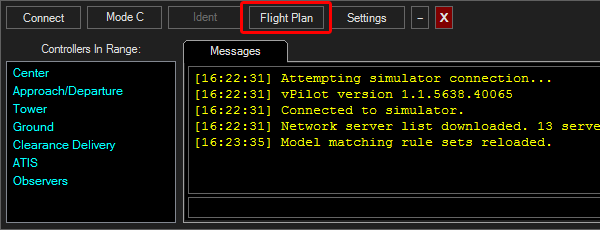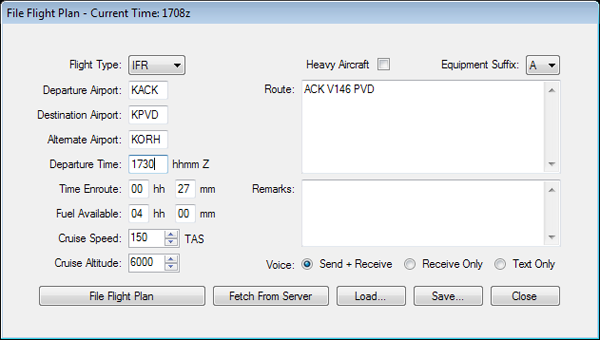
BVA's Getting Started Guide: Start Flying! >> Filing a Flight Plan
Start Flying Navigation>> Get Ready | Before Start Checklist | Setting up your Aircraft | Connecting to the Network | Filing a Flight Plan | Who do I Talk To?
Just like in real life, you are only required to file a flight plan when operating IFR. VFR flight plans are also encouraged.
To file a flight plan, click on the "Flight Plan" button in vPilot:

The "File Flight Plan" window appears:

You must be connected to the network in order to file the flight plan.
Complete the form by entering the following information:
| Block | Details |
| Flight Type | The type of flight plan being filed. Available options are:
|
| Departure Airport | The departure airport for the flight. |
| Destination Airport | The planned arrival airport. |
| Alternate Airport | If operating IFR, the airport you might divert to in the event bad weather is encountered at the destination (not required for VFR). |
Departure Time |
The proposed time of departure, in UTC (or "Zulu"); for reference, the current Zulu time appears in the title bar of the window. |
| Time Enroute | Planned duration of the flight, in hours of minutes. |
| Fuel Available | The amount of fuel on board the aircraft, expressed in hours and minutes of flying time at cruise power settings. |
| Cruise Speed | Planned cruise speed of the aircraft, expressed in True Air Speed (TAS) as knots. |
| Cruise Altitude | The planned altitude for the flight. IFR flights are always flown at altitudes on the thousands.
VFR flights follow the same rules as IFR flights, but add 500' to each altitude. Remember, VFR flight is prohibited in Class A airspace (above 17,999').
|
| Heavy Aircraft | Check this box if the aircraft's maximum takeoff weight is above 300,000 pounds. |
| Equipment Suffix | Select the Equipment Suffix for your navigation capabilities (use our Equipment Type Suffix Selector if you are unsure of which suffix to choose from). |
| Route | Enter the route of flight, including any proposed SIDs or STARs (if operating IFR). VFR routes can be as simple as "Highway 25". If you flying IFR and are unsure of which route to file, BVA maintains a set of Preferred Routes for common citypairs in our airspace. |
| Remarks | Enter any remarks or additional comments in the flight plan. For example, you may wish to enter "New Member" or "Student Pilot" to let controllers know that you are learning the airspace and procedures. |
| Voice | Select "Send + Receive". All BVA members are required to use voice to communicate with ATC. |
Sample VFR flight plan:

Sample IFR flight plan:

Once you have completed the flight plan, click "File Flight Plan". You are now ready to fly!
You can also file your flight plan online. If you file online, there is no need to complete the flight plan form in vPilot.
| Is your flight plan filed? |
| Yes: show me which controller to talk to |
| No, I am not able to file a flight plan |
| Skip this section and explain where I can find more help |